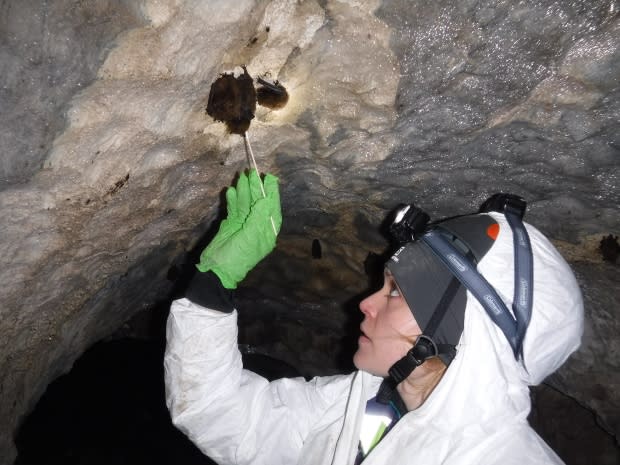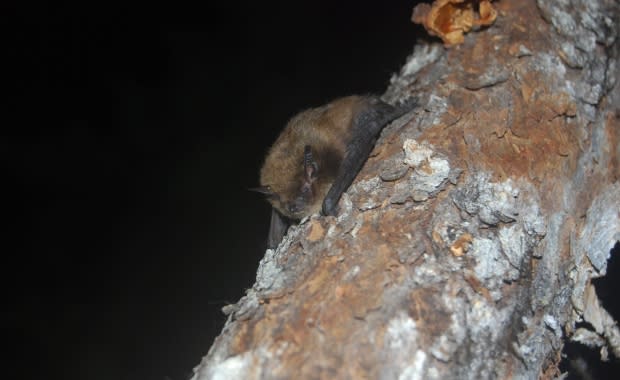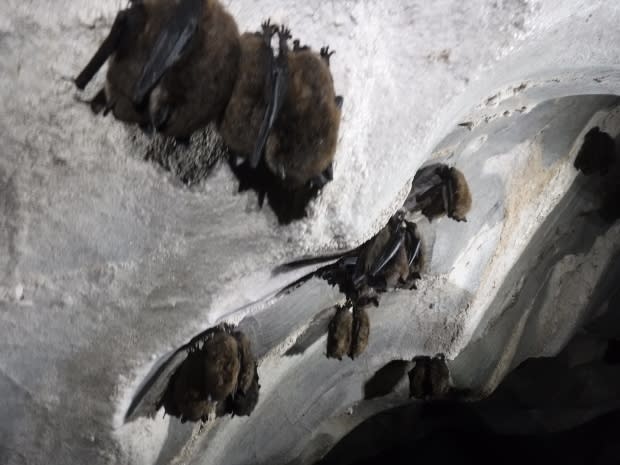Seeing bats? They're likely sick — and government wants to track them
Bat sightings are unusual in this province in the winter months — so unusual, in fact, that the provincial government wants you to report them.
"If you're seeing a bat in the wintertime it has a high probability of being a sick bat," said Jessica Humber, an ecosystem management ecologist responsible for biodiversity at the province's department of fisheries and land resources.
Bats who are on the go at the coldest time of the year might be ones that have had their hibernation interrupted by white nose syndrome, Humber said.
The bats typically spend the winter months hibernating in caves and mines, she said, so reports of their wintertime sightings can both help researchers track white nose syndrome and ensure bat populations in Newfoundland and Labrador stay healthy.

"We wouldn't expect to normally see bats out in the winter, so if they are, it would definitely be a good indication that white nose syndrome might be in the area."
What is white nose syndrome?
White nose syndrome is a disease caused by a fungal pathogen called Pseudogymnoascus destructans (PD). The same warm, high-humidity environment in caves and similar spaces that makes them ideal for hibernation also helps white nose syndrome, which has killed millions of bats in Canada and the United States, spread throughout a population.
"That fungus thrives in those environments, exactly where bats are hibernating," Humber said.
"It spreads very easily between the bats in those sites because the bats cluster together."
The disease causes a white fungus to grow on any exposed skin, particularly around the mouth and ears, damaging wing tissue and disrupting the bats' electrolyte and water balance.
Bats in this province eat only insects, which means they hibernate during the winter months when none are available. The disease causes the bats to wake up frequently when they should be hibernating. When they wake up they lose energy and water, and burn even more of their energy reserves scratching and grooming because the fungus causes irritation, Humber said.

"They either die within the cave and mine and underground sites, or they sometimes leave the site and fly across the landscape looking for food or water — and that's where they'll be discovered," she said.
Track the disease's spread
White nose syndrome has been linked to mass death in hibernating bats in North America since 2006. In New Brunswick, the little brown bat population dropped from 7,000 to 22 in four years after white nose reached the province.
The disease was first picked up in a single bat found on Newfoundland's southwest tip in spring 2017, and several other bats tested positive in 2018.
Scientists know that white nose is present throughout western Newfoundland, as far north as Rocky Harbour, but large-scale effects haven't yet been seen in the bat populations or during hibernation.

However, in other areas where white nose is present, mortality rates of 90-95 per cent have been seen in hibernating bats, so work being done this year to monitor known hibernation sites is important, Humber said.
"We haven't yet seen that, but we know that these bats that have been found in the spring on the landscape have come from somewhere. so we know that there must be infected hibernation sites around.
"It's just a matter of finding them."
The value of citizen science
The confirmation of white nose in western Newfoundland is an example of the value of citizens scientists, Humber said.
"Every one of those bats that tested positive that tested positive throughout western Newfoundland were picked up by a member of the public," she said.
There are several potential ways the public can help the bat population, she said.
Scientists are aware of some bat hibernation sites in the province, particularly in Newfoundland, and population counts and fungal testing are done in hibernation sites as part of annual white nose surveillance that has been happening for a decade.
However, there are many other potential sites that may contain the animals.
"I know that there are many old root cellars in various areas across the province, and no one has really looked into whether these might be alternative overwintering sites for bats," Humber said. In Prince Edward Island, for example, dead bats found outside old wells were the first indication that bats were using those wells to hibernate.
"If we don't know where these sites are, we can't conduct that surveillance," she said. If you know of a site, avoid going inside — it can disturb and spread the spores — but report it to the province's forestry/wildlife division or to the Canadian Wildlife Health Cooperative's toll-free bat line at 1-833-434-BATS.

White nose syndrome has not yet been seen in Labrador, where scientists are not yet aware of any site where bats are overwintering, Humber said. Monitoring is being done there as well, but citizen reports of bats found in winter or known hibernation sites are valuable.
"It's the people of this province who are out snowmobiling, and out ice fishing, and in the back country," she said.
"It's a vast landscape and so we really need the help of all those people out on the landscape watching and reporting all of the observations that they might see."
Read more from CBC Newfoundland and Labrador
